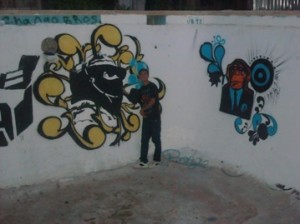
Cesar Espinoza, 17, concentrates on his art work on Tuesday, May 25, 2009. He says he enjoys filling in the lettering of his drawings to make them more colorful by "bubbling in" with blue ink. –Photo by Alejandrina Rangel
CALEXICO, Calif.–When he sees empty walls, Cesar Espinoza starts to picture colorful art and he immediately wants to reach for his miniature spray can to paint graffiti.
The problem for this 17-year-old artist is that his passion is illegal – particularly when his canvas is private property.
“Tagging,” as graffiti art is called by its practitioners, “makes me feel good because I get to express myself,” said Espinoza. He explained that his creativity expands and his art gets better on the large space of a wall rather than on a piece of paper.
Many people, especially the property owners victimized by graffiti artists, might wonder who it is “tagging” their homes, fences, and even their vehicles. Sitting at a railroad crossing, one might see elaborate lettering in vibrant colors on a train’s cargo cars and wonder what the message is and who the messenger might be.
Espinoza is one of those taggers, although unlike a lot of graffiti, Espinoza’s art has no meaning he said, and it is not an expression of claiming gang-related turf.
“I prefer to work alone and sometimes I will tag with one buddy because when cops see too many taggers standing by, it makes it seem like we are part of a gang,” Espinoza said. “If I decide to invite a friend, it is just going to be the two of us,” he added.

Cesar Espinoza, 17, stands inside an empty pool in Heber, California, where a property owner gave him permission to paint his graffiti on the pool’s lining. He says he had time to concentrate on this particular artwork without the fear of being arrested. –Photo by Alejandrina Rangel
The junior at Southwest High School in nearby El Centro, who says one day he would like to be a U.S. Border Patrol agent, was arrested in January 2009 for defacing private property. “Somebody ratted me out,” Espinoza said.
Imperial County Sheriff’s deputies did not catch Espinoza in the act. Instead, they had pictures of him from an unnamed source as evidence of his crime. But when deputies came to arrest him, proud of his artwork, Espinoza admitted to painting the graffiti on apartment complexes near his neighborhood.
During his trial, the judge asked Espinoza if he was a gang member. Defiant about his artistry he responded, “I get ideas in my head and picture colorful art on empty walls. I tag because I do not like to see plain walls.”
Espinoza’s mother, Alma Aguirre, admits that she felt “humiliated” by her son’s arrest, although she’s quick to defend him. “He gets passionate about his work,” she said.
The judge gave Espinoza several options for paying the price of defacing property. They were community service, writing a 500-word essay, offering a verbal or written apology, or facing an “alternative” court of his peers. He and his family chose the latter.
The alternative court, known as a youth peer court, is comprised of juries of middle school and high school students. “We didn’t know what to expect,” said Aguirre. “The court gave my son an opportunity. He received three years probation. This has made him think, and it is part of his growing experience.”

Francisco Garcia complains about the latest vandalism to the fence around his home in Calexico. He says the territorial graffiti is “ugly,” but he won’t paint over it anymore because he says the tagging will just keep reappearing. --Photo by Alejandrina Rangel
Homeowner Francisco Garcia, who lives in the Kennedy Gardens neighborhood of Calexico, might not be so lenient after covering up graffiti on his fencing twice. He says the vandals are territorial taggers, hardly artists.
“You see ‘GARRA’ and it is crossed out and ‘KGS’ beside it,” Garcia said, explaining that the scrawled words all over his fence represent two feuding neighborhood gangs.
“If they see an empty fence, they just paint on it,” Garcia said. “It looks ugly. It’s not art.” He’s decided to just leave the graffiti there, disagreeing with anti-gang authorities and studies that say immediate removal of graffiti discourages vandals.
Calexico Police Officer Carlos Ramirez said much of the graffiti around town is attributed to gang members and skaters, and if the they do enough damage the penalty can be much steeper than peer court, leading to felony charges and prison.
“It is not art,” Ramirez said.
Espinoza, whose probation will last another two years, said it makes him “happy” to see the graffiti he has painted on signs and buildings around town—graffiti, that is, that he did prior to getting caught. But today, instead of sneaking his graffiti onto people’s property, he asks first. He was recently given permission to tag the lining of a neighbor’s pool with a business-suited monkey and an elaborate symbol he can’t explain.
“There is no meaning behind my art,” Espinoza said. “I just like to draw and I find myself tagging my school work.” And he said his teachers like his drawings and encourage him to continue doing his art—on paper.


Bravo, Alejandrina!
This a very interesting story to read. I liked it because it is not a bias article! Good job on that!
This story is told in an engaging way, from the lead to the ending. Good sourcing!
In Nogales, the PD made limonada! Check out this link.
http://www.nogalesinternational.com/articles/2010/05/21/community/doc4bf6a8dc10f02441156820.txt
This is such a great story, I love how you told both sides of it!
This story is very interesting and appealing to both sides! 🙂
Yes the art work is beutiful It needs to be directed in another way. If you plan to express yourself just ask permission. We do have some ugly walls that need art work. Just be sure you ask the owners. I wish I had someone do beutiful art work in my property for free.
I like my story haha =) great job ALEX “DIOS VIVE CARNAL”
esee weii jajaj te la rifas lol xD
hey! Alejandrina , i was reading this article and i just remembered about your article.
http://www.kpbs.org/news/2011/feb/21/police-clamp-down-vandalism-graffiti-artists-eager/
Saludos!